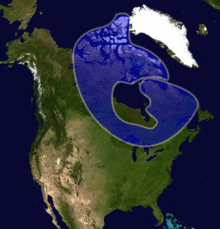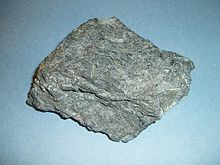Abitibi greenstone belt
The Abitibi Greenstone belt ( English Abitibi Greenstone Belt ) in North America is a neoarchaisches , 2.8 bis 2.6 billion years old rock deposit, located on more than 650 kilometers and 150 kilometers in width along the boundary between the Canadian provinces of Ontario and Quebec of Timmins, Ontario) in the west to Chibougamau (Quebec) in the northeast.
The Abitibi greenstone belt is the largest greenstone belt within the Canadian Shield and belongs to the Superior Province . It consists largely of metamorphic volcanic rock. The 2.45 to 2.2 billion year old sedimentary rocks of the Huron supergroup are discordant on it .
Greenstone belt of Archaean are generally rich in mineral resources . In the Abitibi greenstone belt is the Blake River Megacaldera Complex , which contains the Abitibi gold belt (also: Cadillac Bousquet gold belt) with its numerous gold mines . This green stone belt is one of the regions with the world's most famous and richest deposits of gold and base metals . Mining companies look there for nickel, copper and zinc, as well as diamonds.
Individual evidence
- ↑ a b Excitement in the Abitibi Greenstone Belt ( English ) In: Canadian Mining Journal . 2005. Retrieved October 12, 2016.
- ↑ a b Canadian shield . In: Lexicon of Geosciences . Spectrum Academic Publishing House. Heidelberg. 2000. Retrieved October 12, 2016.
- ↑ Cater, DF (1991): "Macassa Mine Geology". Society of Economic Geologists. Archean Gold Deposits of the Matachewan-Kirkland Lake-Larder Lake Area, Ontario, Canada (Guidebook Series Vol. II): 9-10
- ↑ Grünsteig belt . In: Lexicon of Geosciences . Spectrum Academic Publishing House. Heidelberg. 2000. Retrieved October 12, 2016.

